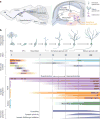Functions and dysfunctions of adult hippocampal neurogenesis
- PMID: 24905596
- PMCID: PMC5531058
- DOI: 10.1146/annurev-neuro-071013-014134
Functions and dysfunctions of adult hippocampal neurogenesis
Abstract
Adult neurogenesis, a developmental process of generating functionally integrated neurons, occurs throughout life in the hippocampus of the mammalian brain and showcases the highly plastic nature of the mature central nervous system. Significant progress has been made in recent years to decipher how adult neurogenesis contributes to brain functions. Here we review recent findings that inform our understanding of adult hippocampal neurogenesis processes and special properties of adult-born neurons. We further discuss potential roles of adult-born neurons at the circuitry and behavioral levels in cognitive and affective functions and how their dysfunction may contribute to various brain disorders. We end by considering a general model proposing that adult neurogenesis is not a cell-replacement mechanism, but instead maintains a plastic hippocampal neuronal circuit via the continuous addition of immature, new neurons with unique properties and structural plasticity of mature neurons induced by new-neuron integration.
Keywords: brain disorders; dentate gyrus; development; neural stem cells.
Figures


Similar articles
-
Increasing adult hippocampal neurogenesis is sufficient to improve pattern separation.Nature. 2011 Apr 28;472(7344):466-70. doi: 10.1038/nature09817. Epub 2011 Apr 3. Nature. 2011. PMID: 21460835 Free PMC article.
-
The role of adult hippocampal neurogenesis in brain health and disease.Mol Psychiatry. 2019 Jan;24(1):67-87. doi: 10.1038/s41380-018-0036-2. Epub 2018 Apr 20. Mol Psychiatry. 2019. PMID: 29679070 Free PMC article. Review.
-
Neurogenesis and hippocampal plasticity in adult brain.Curr Top Behav Neurosci. 2013;15:31-48. doi: 10.1007/7854_2012_217. Curr Top Behav Neurosci. 2013. PMID: 22879073 Review.
-
Plasticity and redundancy in the integration of adult born neurons in the hippocampus.Neurobiol Learn Mem. 2018 Nov;155:136-142. doi: 10.1016/j.nlm.2018.07.007. Epub 2018 Jul 18. Neurobiol Learn Mem. 2018. PMID: 30031119 Review.
-
Adult-Born Hippocampal Neurons Undergo Extended Development and Are Morphologically Distinct from Neonatally-Born Neurons.J Neurosci. 2020 Jul 22;40(30):5740-5756. doi: 10.1523/JNEUROSCI.1665-19.2020. Epub 2020 Jun 22. J Neurosci. 2020. PMID: 32571837 Free PMC article.
Cited by
-
A double-blind, rct testing beneficial modulation of BDNF in middle-aged, life style-stressed subjects: a clue to brain protection?J Clin Diagn Res. 2014 Nov;8(11):MC01-6. doi: 10.7860/JCDR/2014/10301.5141. Epub 2014 Nov 20. J Clin Diagn Res. 2014. PMID: 25584253 Free PMC article.
-
Kv1.1 channels regulate early postnatal neurogenesis in mouse hippocampus via the TrkB signaling pathway.Elife. 2021 May 21;10:e58779. doi: 10.7554/eLife.58779. Elife. 2021. PMID: 34018923 Free PMC article.
-
Transmembrane protein 108 involves in adult neurogenesis in the hippocampal dentate gyrus.Cell Biosci. 2019 Jan 11;9:9. doi: 10.1186/s13578-019-0272-4. eCollection 2019. Cell Biosci. 2019. PMID: 30651970 Free PMC article.
-
Radiation Induces Distinct Changes in Defined Subpopulations of Neural Stem and Progenitor Cells in the Adult Hippocampus.Front Neurosci. 2019 Jan 9;12:1013. doi: 10.3389/fnins.2018.01013. eCollection 2018. Front Neurosci. 2019. PMID: 30686979 Free PMC article.
-
Adult Neural Stem Cell Migration Is Impaired in a Mouse Model of Alzheimer's Disease.Mol Neurobiol. 2022 Feb;59(2):1168-1182. doi: 10.1007/s12035-021-02620-6. Epub 2021 Dec 11. Mol Neurobiol. 2022. PMID: 34894324 Free PMC article.
References
-
- Aimone JB, Gage FH. Modeling new neuron function: a history of using computational neuroscience to study adult neurogenesis. Eur J Neurosci. 2011;33:1160–69. - PubMed
-
- Altman J. In: The Neurosciences: Second Study Program. Quarton GC, Melnechuck T, Schmitt FO, editors. New York: Rockefeller Univ. Press; 1967. pp. 723–43.
Publication types
MeSH terms
Grants and funding
- R01 HD069184/HD/NICHD NIH HHS/United States
- R01 AG024984/AG/NIA NIH HHS/United States
- R37 NS047344/NS/NINDS NIH HHS/United States
- R01HD069184/HD/NICHD NIH HHS/United States
- R21 ES021957/ES/NIEHS NIH HHS/United States
- R37NS047344/NS/NINDS NIH HHS/United States
- R01 NS047344/NS/NINDS NIH HHS/United States
- R01NS048271/NS/NINDS NIH HHS/United States
- R01 MH105128/MH/NIMH NIH HHS/United States
- P01 NS097206/NS/NINDS NIH HHS/United States
- R35 NS097370/NS/NINDS NIH HHS/United States
- R21ES021957/ES/NIEHS NIH HHS/United States
- R01 NS048271/NS/NINDS NIH HHS/United States
LinkOut - more resources
Full Text Sources
Other Literature Sources
Medical

